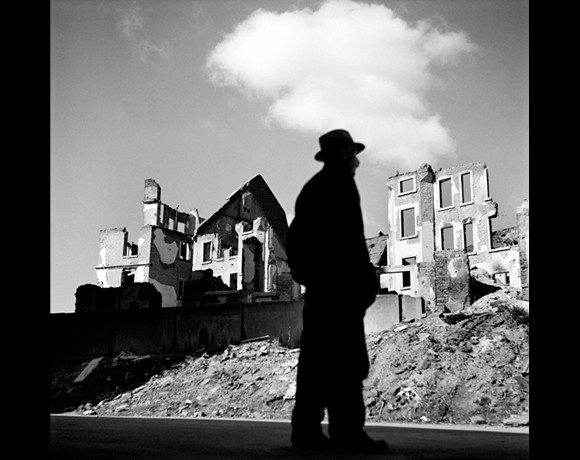Fotofestival
14 Sep - 10 Nov 2013

Ein Mann blickt auf die zerstörte Stadt, Frankfurt, Deutschland, 1946
Werner Bischof/Magnum Photos/FOCUS
Werner Bischof/Magnum Photos/FOCUS
FOTOFESTIVAL
14 September - 10 November 2013
Fotofestival // The Fotofestival Mannheim_Ludwigshafen_Heidelberg runs from September 14 to November 10, 2013. On the occasion of its fifth anniversary, Andréa Holzherr has been invited as curator. Holzherr presents works of the legendary photographic co-operative MAGNUM PHOTOS. The selected photographs deal with geographical, political, economic and private territories and circumambulate both physical and symbolic borderland. The show’s title “Trans-Territories” also plays on the specific characteristics of the Fotofestival with its partner institutions in three cities and in two German federal states.
Under the title Uprooted / Exil the Fotofestival’s exhibition at Kunsthalle Mannheim deals with lack of a homeland, uprooting, exile and migration. The photographic works are integrated with the exhibition Only Sculpture! curated by Bogomir Ecker, bringing documentary photography and sculpture into an exciting dialogue. The first part of the exhibition portrays the end of World War II in Germany with photographs by Robert Capa, Erich Hartmann, Werner Bischof, Herbert List and David Seymor. With the country’s division and the building of the Wall, the flow of refugees within Germany never really ebbs away. René Burri shows 1961 the arrival of East-Germans in the transition-camp Marienfelde in West-Berlin. After the war, new refugees and exiles of the Holocaust also keep arriving in Israel. The division plan of Palestine by the UN and the founding of the State of Israel in May 1948 marked the starting point for the Israeli-Palestinian conflict smoldering up to this day – photographed by George Rodger, Inge Morath, Leonard Freed, Cornell Capa and Bruno Barbey. The second part of the exhibition is called “L’Homme qui marche” and completely avoids any historical, chronological or geographic organisation. In focus are international conflicts since World War II with their masses of exiles and refugees. Comparable in fate and interchangeable in their columns, they walk and drive into an uncertain future: uprooted, homeless and unwelcome. Accompanying the exhibition, Cinema Quadrat shows a series of films entitled “Flucht mit der Flut” (Escape with the flood).
14 September - 10 November 2013
Fotofestival // The Fotofestival Mannheim_Ludwigshafen_Heidelberg runs from September 14 to November 10, 2013. On the occasion of its fifth anniversary, Andréa Holzherr has been invited as curator. Holzherr presents works of the legendary photographic co-operative MAGNUM PHOTOS. The selected photographs deal with geographical, political, economic and private territories and circumambulate both physical and symbolic borderland. The show’s title “Trans-Territories” also plays on the specific characteristics of the Fotofestival with its partner institutions in three cities and in two German federal states.
Under the title Uprooted / Exil the Fotofestival’s exhibition at Kunsthalle Mannheim deals with lack of a homeland, uprooting, exile and migration. The photographic works are integrated with the exhibition Only Sculpture! curated by Bogomir Ecker, bringing documentary photography and sculpture into an exciting dialogue. The first part of the exhibition portrays the end of World War II in Germany with photographs by Robert Capa, Erich Hartmann, Werner Bischof, Herbert List and David Seymor. With the country’s division and the building of the Wall, the flow of refugees within Germany never really ebbs away. René Burri shows 1961 the arrival of East-Germans in the transition-camp Marienfelde in West-Berlin. After the war, new refugees and exiles of the Holocaust also keep arriving in Israel. The division plan of Palestine by the UN and the founding of the State of Israel in May 1948 marked the starting point for the Israeli-Palestinian conflict smoldering up to this day – photographed by George Rodger, Inge Morath, Leonard Freed, Cornell Capa and Bruno Barbey. The second part of the exhibition is called “L’Homme qui marche” and completely avoids any historical, chronological or geographic organisation. In focus are international conflicts since World War II with their masses of exiles and refugees. Comparable in fate and interchangeable in their columns, they walk and drive into an uncertain future: uprooted, homeless and unwelcome. Accompanying the exhibition, Cinema Quadrat shows a series of films entitled “Flucht mit der Flut” (Escape with the flood).
